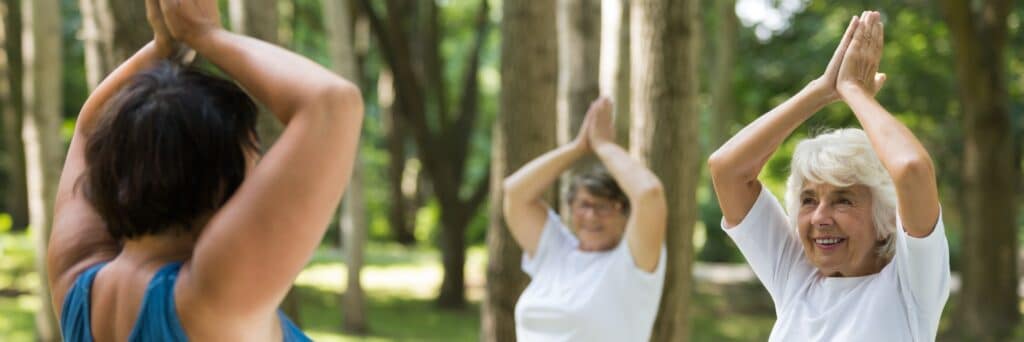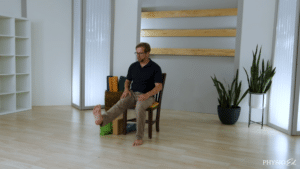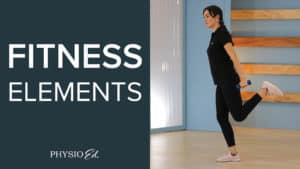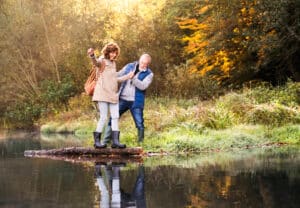Falling is one of the most significant risks for older adults, with one-third of adults over sixty-five experiencing a fall each year. These falls can lead to severe injuries, including fractures and long-term mobility issues.
Fortunately, learning how to improve balance and prevent falls doesn’t have to be complicated. Incorporating a few simple exercises into your daily routine can greatly enhance your stability and reduce your fall risk.
In this article, we’ll explore the factors that contribute to balance decline, the importance of testing balance at home, and practical strategies for improving balance and preventing falls. With these approaches, you can maintain your independence and confidence, ensuring a safer and more active lifestyle.
Why Is There An Increased Risk of Falling With Age?

Poor postural control is a primary risk factor that increases the chance of falls for many older adults. Postural control requires coordination between several parts of your brain and body; it is not only limited to muscular strength.
Age can contribute to limited vision and depth perception, making it difficult to see potential fall hazards. The structures in our ears that help us balance can also be affected, causing problems like vertigo or difficulty maintaining balance.
These factors, combined with decreased lower extremity strength and sensation, also increase the risk of falling in older adults. According to the Centers for Disease Control and Prevention, 95% of hip fractures are caused by falls in older adults, primarily due to these common age-related conditions.
Fortunately, an at-home practice of fall prevention strategies and simple exercises can lessen risk factors related to aging.
Testing Balance at Home to Prevent Future Falls
There are a few ways to test balance at home. Keep a chair or countertop nearby to steady yourself, and feel free to use a cane, walker, or any other assistive device that helps you feel safe. Please remember that it’s normal to feel a little unsteady.
If you feel unsafe, consult your doctor or physical therapist before starting this or any other exercise program.
Narrow-Stance Balance Test
Stand with your feet together and your arms folded across your chest. Take several deep breaths and try to hold this position for one minute or more.
Balance Beam Stance
Position your left foot directly in front of your right, heel-to-toe. Again, breathe deeply, do your best to relax, and aim for 30-40 seconds on each side.
Single Leg Balance Test
Stand on one foot and bend your opposite knee, lifting it off the floor with your eyes open. Start this test with your hands on a stable surface, and gradually remove your hands. Try to complete a twenty-second hold on each leg.
We encourage you to remember standing on one foot is challenging for most people. If you struggle with one or all of these tests, continue to practice. Next, we’ll look at a group of exercises to help you improve balance to prevent falls.
The Best Exercises to Improve Balance and Prevent Fall Injuries
We have put together a short list of some of our favorite exercises to get you started on your fall prevention journey. Here are a few simple exercises to prevent falls and keep you moving:
Supported single-leg balance
We touched on this test previously, but we’d encourage you to work on it as much as possible. In this case, it will serve as a warm-up for your fall prevention program.
- Hold on to a countertop or sturdy chair.
- Slowly lift one foot off the floor and hold for as long as possible without putting your foot down.
- You can try standing on an unstable surface, such as a folded blanket, or close your eyes as you improve.
Remember not to hold your breath. Also, the risk of falls increases on an uneven surface, so be sure you have something you can rely on for support.
Walking the Line
This exercise will challenge your balance as you move.
- Place a piece of masking tape on your floor, about eight-to-ten feet in length
- Start with one foot at the end of the tape, and place your other foot in line, heel-to-toe.
- ‘Walk the line’ slowly, then turn around and walk back. If ‘walking the line’ feels too challenging, just walk with your feet slightly narrower than usual.
Sit-to-Stand
- Sit upright in a sturdy chair and take a few deep breaths. Feel your feet on the ground, and take a few deep breaths.
- From a seated position, carefully stand up, feeling the pressure of your feet flat on the floor, driving up to a tall standing posture.
- Carefully sit back down, focusing on the sensations in your feet and legs. Complete this exercise slowly for eight to twelve repetitions and rest as needed.
Heel Taps
This exercise challenges your balance and builds strength in the knees and upper legs.
- Start standing with your hands on your hips, and lift one foot off the floor. Feel free to use a light hand on a table or chair for added support
- Bend the standing leg slightly, and reach your lifted heel forward to tap the floor about a foot in front of the standing leg.
- Repeat twelve repetitions on one leg, then switch. As you improve, you can keep both hands on your waist or even stand on a folded towel for an added balance challenge.
Slow Squat with a Hold
This exercise will help to build strength, muscle mass, and body awareness in the whole lower body:
- Stand with your feet shoulder-width apart, and bend at your knees and hips as if preparing to sit on a tall chair.
- Once you feel like the depth is challenging the muscles in your legs, hold that position and take three deep breaths. Focus on really feeling the muscles in your legs. Note: it is unnecessary to go especially low, as the main challenge in this exercise is holding the position.
- Aim to perform two to three sets of eight squats, with a three-to-five-second hold for each repetition, and rest between sets.
Group Activities
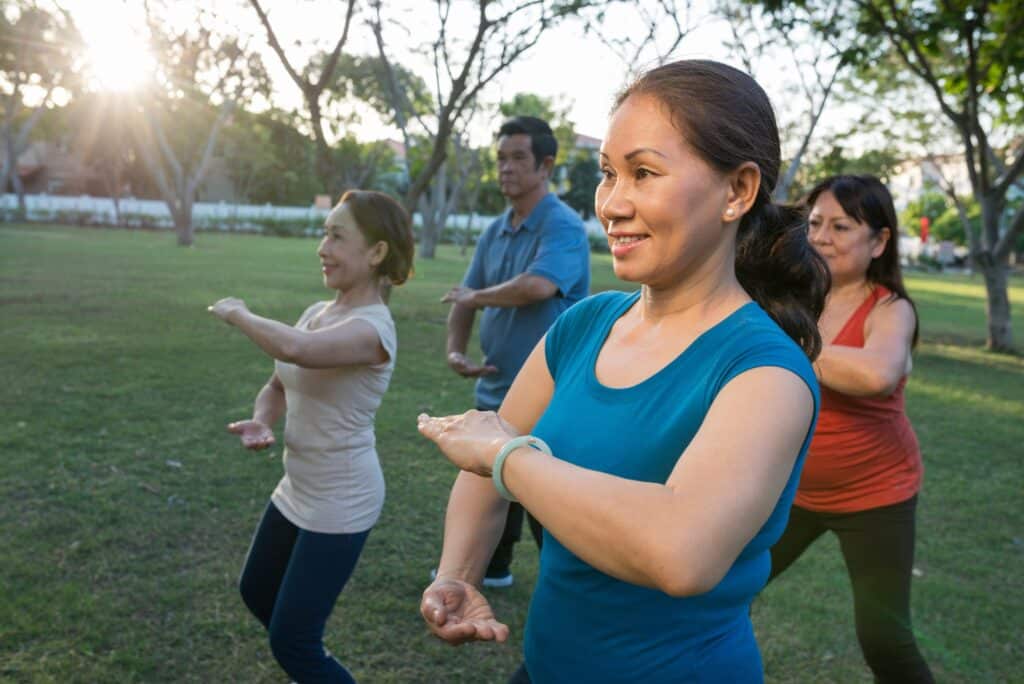
Various exercises can be beneficial for balance and for interacting with other seniors and community members. Check your local fitness facility for tai chi, gentle yoga, or even dance classes to add variety to your workouts.
If you’re seeking more in-depth exercises, consider consulting a physical therapist specializing in fall prevention. Various clinics have specially designed fall prevention programs that can be individually tailored to your goals. For more severe balance problems, a physical therapist can help to get you back on track with the correct exercises to meet your goals.
PhysioEd also offers several online classes for older adults to combat fall risks.
Key Takeaways
- Falls are a significant risk for older adults, with one-third of adults over sixty-five falling annually.
- Aging affects postural control, vision, balance, and lower body strength, increasing fall risks.
- Simple at-home exercises can help improve balance and reduce the risk of falls.
- Testing your balance at home is a helpful way to assess and prevent future falls.
- Exercises like single-leg balance, walking the line, and sit-to-stand can strengthen muscles and enhance balance.
- Group activities such as tai chi, yoga, and dance classes can improve balance and provide social interaction.
- Consulting a physical therapist for a personalized fall prevention program can be beneficial.
- Maintaining regular balance exercises and addressing fall risks can enhance safety and mobility.
FAQs
What are the main reasons older adults are at a higher risk of falling?
Older adults face an increased risk of falling due to several interconnected factors. As people age, their postural control weakens, making it more challenging to maintain balance. This issue is compounded by age-related declines in vision, such as reduced depth perception and peripheral awareness, which make it harder to spot and avoid potential hazards. Additionally, changes in the inner ear, which play a crucial role in balance, can cause dizziness or vertigo. Lower body strength often decreases with age, leading to less stable movements and a higher likelihood of tripping or stumbling. Together, these factors create a perfect storm that significantly elevates the risk of falls among older adults.
How can I test my balance at home to prevent future falls?
Testing your balance at home is a proactive way to assess your fall risk and begin strengthening your stability. Simple exercises such as the narrow-stance balance test, balance beam stance, and single-leg balance test can give you a clear idea of your current balance abilities. For example, you can stand with your feet together and arms folded, trying to maintain the position for at least a minute. Another exercise involves standing heel-to-toe like you’re on a balance beam, holding the position for 30-40 seconds. The single-leg balance test, where you stand on one foot for 20 seconds, is another excellent way to gauge balance. Always keep a sturdy chair or countertop nearby for support, and if you feel unsteady, consult your doctor or a physical therapist before continuing these exercises.
What are some practical exercises to improve balance and prevent falls?
Several exercises are designed to improve balance and prevent falls, particularly for older adults. Supported single-leg balance is a foundational exercise where you hold onto a stable surface, lift one foot off the ground, and maintain the position as long as possible. “Walking the line,” where you place one foot directly in front of the other as if walking on a tightrope, helps refine your balance while moving. Sit-to-stand exercises, which involve repeatedly rising from a seated position, strengthen your legs and enhance stability. Heel taps target lower body strength and coordination by having you tap your heel forward while standing on one leg. Lastly, slow squats with a hold build overall leg strength and muscle endurance, which are crucial for maintaining balance. Incorporating these exercises into your routine can significantly reduce your fall risk.
How can group activities help in fall prevention?
Group activities such as tai chi, gentle yoga, and dance classes improve balance and prevent falls. These activities enhance your physical stability and offer a social component, which can boost your motivation and enjoyment. Tai chi, for instance, focuses on slow, deliberate movements that improve balance, flexibility, and muscle strength. Gentle yoga increases body awareness and coordination, helping you move more confidently. Dance classes, with their varied movements, improve agility and reaction time, which are critical for preventing falls. Regular participation in these group activities can significantly improve your balance and overall physical health while keeping you socially connected and mentally engaged.
When should I consider consulting a physical therapist for fall prevention?
If you experience frequent instability, have a history of falls, or notice a significant decline in your balance, it’s time to consult a physical therapist for fall prevention. A physical therapist can comprehensively assess your balance and mobility, identifying specific areas of weakness or instability. They can then create a personalized exercise program tailored to your needs to improve strength, flexibility, and coordination. For those with more severe balance issues, a therapist may introduce specialized equipment or techniques to help you regain stability. Consulting a physical therapist early can prevent falls, reduce your risk of injury, and help you maintain your independence and quality of life.
Resources
- Hafström A, Malmström EM, Terdèn J, Fransson PA, Magnusson M. Improved Balance Confidence and Stability for Elderly After 6 Weeks of a Multimodal Self-Administered Balance-Enhancing Exercise Program: A Randomized Single Arm Crossover Study. Gerontol Geriatr Med. 2016 Apr 26;2:2333721416644149. doi: 10.1177/2333721416644149. PMID: 28138495; PMCID: PMC5119910.
- https://www.cdc.gov/injury/features/older-adult-falls/index.html
- Dunsky, A. (2019). The Effect of Balance and Coordination Exercises on Quality of Life in Older Adults: A Mini-Review. Frontiers in Aging Neuroscience, 11. https://doi.org/10.3389/fnagi.2019.00318
- Thiamwong, L., & Suwanno, J. (2014). Effects of Simple Balance Training on Balance Performance and Fear of Falling in Rural Older Adults. International Journal of Gerontology, 8(3), 143-146. https://doi.org/10.1016/j.ijge.2013.08.011


